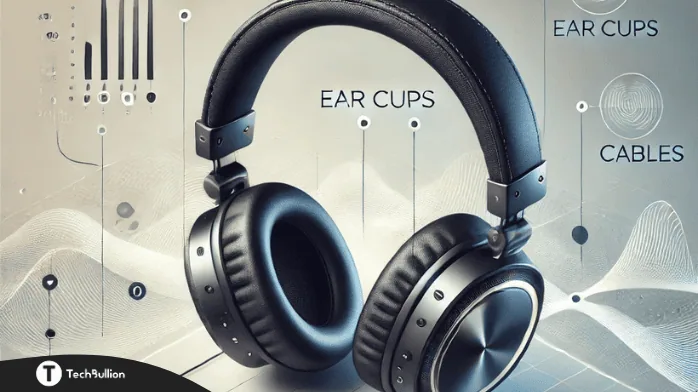
Headphones are essential for delivering high-quality sound, whether for music, gaming, or professional use. However, few people truly understand the components that make up these devices and how they work together. In this article, we will break down the Parts of Headphones: Headphone Components, explaining each element and its importance. This guide will help you make informed decisions when purchasing or maintaining headphones.
Introduction to Parts of Headphones: Headphone Components
Headphones components may seem simple on the outside, but they are composed of several key parts that ensure you enjoy clear, crisp, and balanced audio. Understanding these components allows you to choose better headphones, customize them, and even troubleshoot common issues.
Main Parts of Headphones: Headphone Components
Here are the essential parts that make up most headphones:
1. Drivers of Parts of Headphones: Headphone Components
The driver is the most crucial component of headphones. It converts electrical signals into sound. Think of it as the engine of your headphones that produces the audio you hear.
Types of Headphone Drivers:
- Dynamic Drivers: Most common, delivering powerful bass and sound clarity.
- Planar Magnetic Drivers: Found in high-end headphones, offering detailed and accurate sound.
- Electrostatic Drivers: Used in premium audiophile headphones for unparalleled precision.
- Balanced Armature Drivers: Often used in in-ear monitors for professional-grade sound.
Tip: Larger drivers tend to produce better bass, but the overall quality also depends on the materials and design.
2. Ear Cups of Parts of Headphones: Headphone Components
The ear cups are the part of the headphones that cover your ears. They play a significant role in comfort and sound isolation.
Types of Ear Cups:
- Over-Ear: Completely cover your ears, offering superior comfort and noise isolation.
- On-Ear: Sit on your ears; more compact but less isolating.
- In-Ear: Fit inside the ear canal; ideal for portability and active lifestyles.
Materials Used:
- Leather, memory foam, and synthetic fabrics are common for cushioning.
- Choose breathable materials for prolonged use to avoid ear fatigue.
3. Headband
The headband holds the headphones in place. It ensures a secure and comfortable fit for extended listening sessions.
Features to Look For:
- Adjustability: Adjustable headbands accommodate different head sizes.
- Padding: Cushioned headbands reduce pressure on the head.
- Material: Look for lightweight and durable materials such as metal, plastic, or reinforced composites.
4. Cables and Connectors
Cables and connectors are essential for wired headphones, as they transmit audio signals from the device to the drivers.
Key Components:
- Cables: Made of copper or silver-plated wires covered with protective insulation.
Connector Types:
- 3.5mm Jack: Most common for portable devices.
- 6.3mm Jack: Standard for professional audio equipment.
- USB/USB-C: Used in digital headphones and gaming headsets.
- Bluetooth (Wireless): Eliminates the need for cables altogether.
Tip: Look for tangle-free cables or detachable options for added convenience and durability.
MyFastBroker.com Forex Brokers: The Ultimate Trading Journey
Optional Components of Parts of Headphones: Headphone Components
Many headphones come with additional features to enhance performance, including:
- Microphones: Built-in or detachable for gaming and calls.
- Noise-Canceling Technology: Reduces background noise for a better listening experience.
- Volume Controls: Integrated into the cables or ear cups for easy adjustment.
- Ear Pads: Replaceable pads for customization and comfort.
Why Understanding Parts of Headphones: Headphone Components Matters
Knowing the parts of headphones helps you:
- Make Informed Purchases: Understand the differences in materials, drivers, and features to select the right headphones for your needs.
- Maintain Headphones: Replace worn-out parts like ear pads or cables instead of buying new headphones.
- Customize Your Experience: Choose features like noise cancellation or replaceable cables for optimal performance.
Apex Traffic vs ClickSEO: Website’s Growth
Conclusion of Parts of Headphones: Headphone Components
Understanding the parts of headphones empowers you to appreciate the engineering behind these essential devices. From the drivers that produce sound to the headbands that offer comfort, each component plays a vital role. Whether you are a music lover, gamer, or audiophile, learning about headphone components ensures you get the most out of your listening experience.
FAQs
1. What is the most important part of headphones?
The driver is the most important part, as it converts electrical signals into sound.
2. Can I replace parts of my headphones?
Yes, components like ear pads, cables, and headbands are often replaceable, depending on the headphone model.
3. What is the difference between dynamic and planar magnetic drivers?
Dynamic drivers are common and produce powerful bass, while planar magnetic drivers offer more detailed and accurate sound.
4. How do I choose comfortable headphones?
Look for adjustable headbands, cushioned ear cups, and lightweight materials for maximum comfort.
5. What is the role of cables in headphones?
Cables transmit audio signals from your device to the drivers, ensuring clear sound quality.




